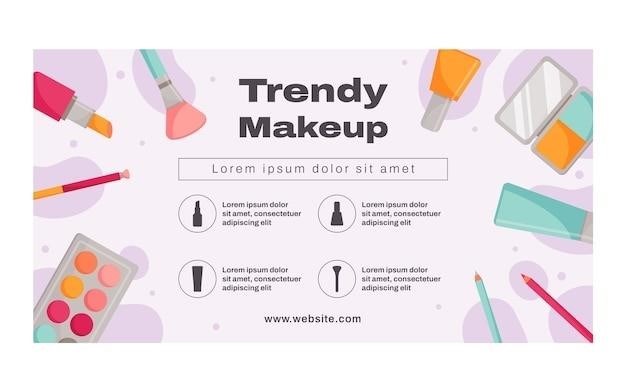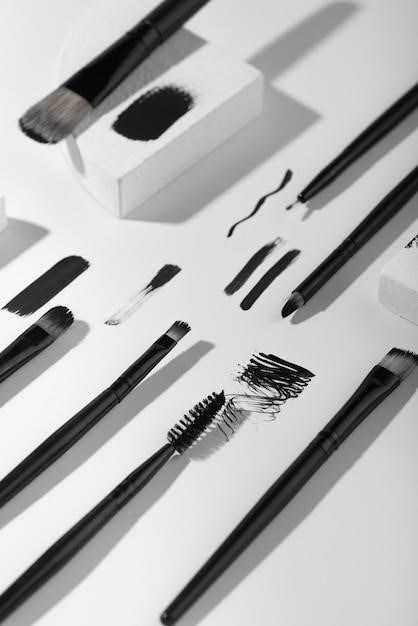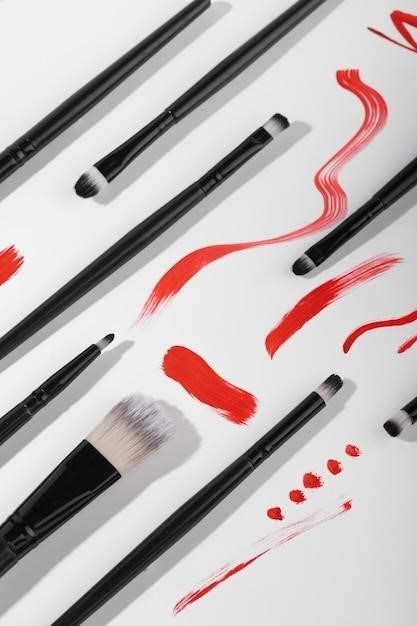Guide to Makeup Brushes⁚ A Comprehensive Overview
This guide explores the diverse world of makeup brushes, covering essential types, application techniques, and maintenance tips․ Learn how to select the right brushes for your skill level and budget, achieving flawless makeup application․
Essential Face Brushes
Several key brushes form the foundation of any successful makeup routine․ The powder brush, typically large and fluffy with soft bristles, is essential for applying and blending setting powder or bronzer evenly across the face, achieving a seamless, airbrushed finish․ A tapered foundation brush, characterized by its dense, angled head, allows for precise application and controlled blending of liquid or cream foundations, ensuring even coverage without streaks․ The versatile stippling brush, with its unique dual-fiber design, imparts a natural, luminous finish to liquid or cream products, creating a flawless, almost airbrushed effect․ For a more full-coverage look, the kabuki brush, known for its dense, rounded head, provides excellent blending capabilities and an even application of foundation or other face makeup․
Finally, the contour brush, usually with an angled or tapered shape, is designed for precise application of contouring products to sculpt and define the facial features․ Its angled shape allows for easy application in the hollows of the cheeks, along the jawline, and along the temples․
Foundation Brushes⁚ Types and Techniques
Selecting the right foundation brush significantly impacts your makeup application․ Flat foundation brushes, with their dense, flat bristles, provide excellent coverage, ideal for building a full-coverage look․ Their flat shape allows for precise application and even distribution of foundation across the face․ For a more natural, sheer coverage, consider a buffing brush․ Its densely packed, rounded head buffs the foundation into the skin, creating a flawless, almost airbrushed finish․ This technique minimizes the appearance of pores and fine lines, resulting in a smoother complexion․
The stippling brush, with its unique dual-fiber design, offers a buildable coverage, blending foundation seamlessly for a naturally radiant finish․ For those seeking a quick and easy application, a kabuki brush’s dense bristles provide excellent coverage and blending in minimal time․ Regardless of brush choice, the application technique is crucial․ Start by dispensing a small amount of foundation onto the back of your hand․ Using small, circular motions, gently blend the foundation outwards, starting from the center of your face and working your way outwards․
Powder and Blush Brushes⁚ Achieving a Flawless Finish
Powder brushes, typically large and fluffy with soft bristles, are essential for setting makeup and achieving a smooth, even finish․ Their large size allows for quick and even application of powder across the entire face, preventing cakey buildup․ Look for brushes made from soft, natural or synthetic fibers that won’t irritate the skin․ The application technique is simple⁚ lightly dust the powder brush into the powder compact, tapping off excess powder to avoid heavy application․ Sweep the brush across the face in gentle, circular motions, focusing on areas prone to shine such as the T-zone․
Blush brushes, often smaller and more angled than powder brushes, are designed for precise application of blush to the cheeks․ The angled shape helps to contour the cheekbones, while the soft bristles blend the blush seamlessly into the skin, creating a natural flush․ For a more intense color payoff, use a denser brush with shorter bristles; for a softer, more diffused look, opt for a fluffier brush․ When applying blush, smile to locate the apples of your cheeks․ Apply the blush to the apples, then blend upwards and outwards towards the temples for a natural, lifted effect․ Remember to blend well to avoid harsh lines․
Contouring and Highlighting Brushes⁚ Sculpting Your Features
Contouring brushes are typically angled or have a tapered shape, designed for precise application of contour powder or cream․ The angled shape helps to define the cheekbones, jawline, and forehead, creating depth and dimension․ Look for firm yet soft bristles that can pick up and blend the contour product without streaking․ Apply contour powder or cream to the hollows of your cheeks, along your hairline, and under your jawline, following the natural shadows of your face․ Blend thoroughly using gentle, sweeping motions to avoid harsh lines and create a natural-looking shadow․
Highlighting brushes, on the other hand, are often fan-shaped or have soft, rounded bristles․ These brushes are designed to apply highlighter to the high points of your face, enhancing your features and adding luminosity․ Look for soft, fluffy bristles that can blend the highlighter seamlessly into the skin without creating harsh streaks․ Apply highlighter to the tops of your cheekbones, the bridge of your nose, your cupid’s bow, and the center of your forehead․ Use gentle dabbing motions to apply the highlighter, then blend with soft, sweeping strokes for a natural, radiant glow․ The right technique ensures a subtle, illuminated look rather than a stark contrast․
Eye Makeup Brushes⁚ Mastering the Eyes
Eye makeup application requires a variety of brushes to achieve different effects․ For eyeshadow application, several brush shapes are crucial․ A fluffy blending brush is essential for seamlessly blending eyeshadow colors together, preventing harsh lines and creating a smooth, gradient effect․ A flat shader brush is perfect for packing on intense color to the eyelid, while a small, angled brush allows for precise application in the crease to define the eye shape․ Experiment with different sizes and shapes to find your preferences․
Eyeliner brushes come in various shapes and sizes, offering different levels of precision․ Fine-tipped brushes are ideal for creating sharp, defined lines, while angled brushes are great for a more dramatic, winged look․ For precise application, use light, even strokes, building up the intensity gradually․ For smudged, smoky effects, use a smudging brush to blend out the eyeliner, creating a soft, diffused look․ Practice is key to mastering different eyeliner techniques․
Brow brushes are also essential for shaping and defining eyebrows․ An angled brow brush works well with brow powder or pomade to fill in sparse areas and create a natural-looking shape․ A spoolie brush, which is essentially a small mascara wand, helps to comb through and blend the brow product, achieving a polished finish․ Choose brushes with firm yet soft bristles for optimal control․
Eyeshadow Brushes⁚ Application and Blending
Mastering eyeshadow application hinges on selecting the right brushes and understanding their unique functions․ Fluffy blending brushes, characterized by their soft, tapered bristles, are paramount for seamlessly blending eyeshadow colors․ Their airy texture prevents harsh lines, creating a smooth, gradient effect that’s essential for a polished look․ Use gentle, circular motions to diffuse colors and avoid harsh transitions․
Flat shader brushes, with their densely packed bristles, excel at packing on intense color․ Perfect for applying base shades or creating a bold, saturated look, these brushes allow for precise application of pigment, maximizing color payoff․ Use short, dabbing motions to apply color evenly across the eyelid․
Pencil brushes, known for their small, pointed tips, are ideal for detailed work, such as applying color to the crease or creating a sharp wing․ Their precise application allows for intricate detailing and control over placement․ Use light, feathery strokes for a natural look, or build up intensity for a more dramatic effect․ Remember to always clean your brushes after each use to maintain their shape and hygiene․
Eyeliner and Eyebrow Brushes⁚ Precision and Definition
Achieving precise eyeliner application requires the right tools․ Angled eyeliner brushes, with their slanted bristles, offer exceptional control for creating sharp, defined lines․ Their angled shape allows for easy maneuvering along the lash line, whether you prefer a thin, delicate line or a bold, dramatic wing․ Dip the brush into your eyeliner, gently wiping off excess product to avoid smudging, and use short, controlled strokes to create your desired look․

For eyebrow grooming and definition, spoolie brushes are indispensable․ These small, brush-like applicators are designed to tame and shape eyebrows, effectively distributing eyebrow gel or pomade․ Use the spoolie to brush brows upwards, setting them in place and creating a natural, polished appearance; For more precise shaping and filling, consider using an angled eyebrow brush․ Its angled tip allows you to mimic individual hair strokes, creating a natural and fuller-looking brow․
Remember to clean your eyeliner and eyebrow brushes regularly to prevent bacteria buildup and maintain hygiene․ Proper cleaning ensures that your brushes remain in optimal condition, delivering consistent and precise application each time you use them․
Specialized Brushes⁚ Beyond the Basics
Beyond the fundamental face and eye brushes, a range of specialized tools enhances makeup application․ Concealer brushes, typically small and densely packed, offer precise product placement for concealing blemishes or dark circles․ Their fine tips allow for targeted application without disturbing surrounding makeup․ For a flawless, airbrushed finish, consider using a stippling brush․ Its unique design, with short, densely packed bristles, buffs makeup into the skin, creating a seamless and natural-looking application․ This technique is particularly useful for applying cream or liquid products․
Another specialized brush is the fan brush, a unique tool with long, splayed bristles․ Primarily used for highlighting or applying loose powder, its delicate design allows for precise placement of shimmer or setting powder to the high points of the face․ It is also useful for gently removing excess product or fallout from eyeshadow application, ensuring a clean and polished look․ Finally, lip brushes provide precise lip color application, ensuring a clean and defined lip line․
These specialized brushes, while not essential, significantly elevate makeup artistry, providing greater control and precision for a professional finish․
Brush Materials⁚ Synthetic vs․ Natural Hair
Makeup brushes are crafted from either natural or synthetic hair, each offering distinct advantages․ Natural hair brushes, typically made from animal hair like sable, goat, or pony, are prized for their softness and ability to pick up and blend cream and powder products seamlessly․ The unique structure of natural hair allows for a superior blending capability, creating a smooth, even finish․ However, natural hair brushes often require more meticulous care and can be more expensive․ They may also be less hygienic for those with allergies or sensitivities․
Synthetic brushes, crafted from nylon or other synthetic fibers, offer a more affordable and hygienic alternative․ Modern synthetic fibers are engineered to mimic the performance of natural hair, providing excellent blending capabilities for a variety of makeup textures․ Synthetic brushes are generally easier to clean and maintain, and they are often cruelty-free, appealing to ethically conscious consumers․ While some may find them slightly less soft than natural hair brushes, advancements in fiber technology have significantly narrowed this gap․
The choice between natural and synthetic brushes ultimately depends on personal preference, budget, and ethical considerations․ Both offer excellent performance when chosen appropriately for the intended makeup application․
Cleaning and Maintaining Your Brushes⁚ Prolonging Their Life
Regular cleaning is crucial for maintaining the hygiene and longevity of your makeup brushes․ Dirty brushes harbor bacteria and product buildup, compromising both the application of makeup and your skin’s health․ A simple, yet effective, cleaning method involves wetting the brush bristles with lukewarm water and gently swirling them into a mild cleanser designed specifically for makeup brushes․ Avoid harsh soaps that can damage the bristles or their glue․
Thoroughly rinse the bristles under running water, ensuring all traces of cleanser and makeup residue are removed․ Gently squeeze out excess water, reshaping the bristles to their original form․ Lay the brushes flat on a clean towel to air dry, avoiding placing them upright, which can cause water to seep into the handle and damage the brush’s structure․ For a deeper clean, consider using a brush cleaning mat or tool to help remove stubborn product buildup from within the bristles․
The frequency of cleaning depends on usage, but a weekly deep clean is recommended for brushes used regularly․ Proper cleaning and storage significantly extend the lifespan of your brushes, ensuring they remain effective and hygienic for years to come, maintaining their performance and providing a superior makeup application experience․

Choosing the Right Brushes for Your Needs⁚ Budget and Skill Level
Selecting makeup brushes involves considering both budget and skill level․ Beginners might start with a basic set including a foundation brush, powder brush, and eyeshadow brush․ These essentials provide a foundation for experimenting with different makeup techniques without overwhelming investment․ As skills develop, more specialized brushes can be added gradually, such as contouring, highlighting, and angled eyeliner brushes․ Budget-conscious individuals can opt for synthetic brushes, which are often more affordable and easier to clean․
Higher-end brushes, typically made from natural hair, offer softer application and better blending capabilities, but come with a greater price tag․ The choice depends on individual preferences and priorities․ Investing in high-quality brushes, regardless of price point, ensures durability and performance․ Consider the handle’s material and design for comfort and control during application․ A comfortable grip enhances the overall experience, preventing hand fatigue during longer makeup routines․ Reading reviews and comparing different brush sets can aid informed decision-making, matching needs and budget effectively․
Ultimately, building a brush collection is a personal journey․ Start with the essentials, gradually expanding based on skill and budget, focusing on quality over quantity to create a versatile and effective makeup application experience․
Frequently Asked Questions about Makeup Brushes
Q⁚ How often should I clean my makeup brushes? A⁚ Ideally, clean your brushes after each use to prevent bacterial buildup and maintain hygiene․ At a minimum, weekly cleaning is recommended, especially for brushes used with cream or liquid products․ Proper cleaning extends the life of your brushes and ensures flawless application․
Q⁚ What’s the best way to clean makeup brushes? A⁚ Gentle cleansers are best; avoid harsh soaps that can damage the bristles․ Use a brush-cleaning mat or your palm to gently massage the bristles with a cleanser and lukewarm water․ Rinse thoroughly until the water runs clear․ Reshape the bristles and lay them flat to dry completely, avoiding direct sunlight or heat․
Q⁚ Synthetic vs․ natural hair brushes – which are better? A⁚ Both have advantages․ Synthetic brushes are generally more affordable, easier to clean, and cruelty-free․ Natural hair brushes, often made from sable or goat hair, provide a softer, more luxurious application and are better at picking up and blending powder products․ The choice depends on personal preference and budget․
Q⁚ How do I store my makeup brushes? A⁚ Store your brushes upright in a container or stand to maintain their shape and prevent damage․ Avoid storing them in humid or dusty areas․ Consider a protective case for travel to keep them organized and protected from damage․

